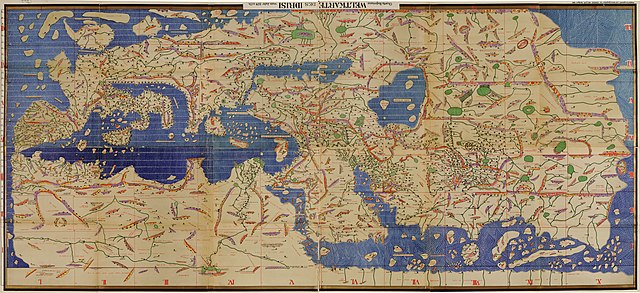Siculo-Arabic or Sicilian Arabic (Arabic: اللَّهْجَة الْعَرَبِيَّة الصِّقِلِّيَّة, romanized: al-lahja l-ʿarabiyya ṣ-ṣiqilliyya) is the term used for varieties of Arabic that were spoken in the Emirate of Sicily (which included Malta) from the 9th century, persisting under the subsequent Norman rule until the 13th century.[3] It was derived from Arabic following the Abbasid conquest of Sicily in the 9th century and gradually marginalized following the Norman conquest in the 11th century.
| Siculo-Arabic | |
|---|---|
| Sicilian Arabic | |
| العربية الصقلية | |
| Native to | Emirate of Sicily |
| Era | 9th–13th centuries[1] developed into Maltese |
| Dialects | |
| Arabic alphabet | |
| Language codes | |
| ISO 639-3 | sqr |
| Glottolog | sicu1235 |
Siculo-Arabic is extinct and is designated as a historical language that is attested only in writings from the 9th–13th centuries in Sicily.[4][5] However, present-day Maltese is considered to be its sole surviving descendant. Maltese evolved from one of the dialects of Siculo-Arabic over the past 800 years and a gradual process of Latinisation that gave Maltese a significant superstrate influence from Romance languages.[6][7][8] By contrast, present-day Sicilian, which is an Italo-Dalmatian language, retains relatively little Siculo-Arabic vocabulary; its influence is limited to some 300 words.[9]
History
Introduction to Sicily
During the 7th and 8th centuries, Sicily was raided from Tunis. The eventual Muslim Arab conquest of Byzantine Sicily was piecemeal and slow. The region was a frontier zone, even after the fall of Taormina in 962, which completed the invasion. Romance languages, such as African Romance, and Byzantine Greek continued to be used in the island well after the Arabic conquest.[10] Its speakers were largely made up of Sicilian Muslims. However, based on the foundation charter on the Church of Santa Maria dell'Ammiraglio (written in both Greek and Arabic), it can be speculated that Siculo-Arabic was also the mother tongue for many Sicilian, in this case Palermo’s, Orthodox Christians.[11]
Norman kingdom of Sicily
When the Normans entered Sicily, the island was divided into two main non-Latin linguistic groups:
- Arabic speakers, mostly in Palermo, Agrigento, Butera, Enna and Noto
- Greek speakers, mostly in Messina, Taormina, Cefalù, Catania and Syracuse
In 1086, the Normans managed to secure the conversion of the last important Kalbid ruler of Enna Ibn Hamud.[12] This conversion along with the Norman adoption of many Arab governing customs resulted in the emergence of a Christian Siculo-Arabic language. During the Norman era the chancery office operated in Arabic, Greek and Latin.[13]

The Nuzhat al-mushtāq fi'khtirāq al-āfāq (Arabic: نزهة المشتاق في اختراق الآفاق, lit. "the book of pleasant journeys into faraway lands"), most often known as the Tabula Rogeriana (lit. The Book of Roger in Latin) is a description of the world and world map created by the Palermo-based Arab geographer Muhammad al-Idrisi in 1154. Al-Idrisi worked on the commentaries and illustrations of the map for fifteen years at the court of the Norman King Roger II of Sicily, who commissioned the work around 1138.[14][15][clarification needed]
Decline after 1200
In the post-conquest period, both Arabic and Greek were sometimes used by the new rulers and subsequently used in the king's fiscal administration, which managed royal lands and men in Sicily and Calabria.[16] The many documents that it issued are among the main and most important sources for Arabic in Sicily. However, when the Hohenstaufen replaced the Normans, Arabic was dropped as a language of government in 1198[17] and the Hohenstaufen expelled the remaining Muslims to Lucera and North Africa in the 13th century. Due to the expulsions, the only remaining Siculo-Arabic speakers were Christians.[18]
When the Aragonese took Sicily, they introduced Catalan nobility, made Latin the only official language; Greek and Arabic official records in Sicily ceased to exist by the 14th century.[19]
Arabic influence continued in a number of Sicilian words. Most of these terms relate to agriculture and related activities.
Maltese language
The modern language derived from the Siculo-Arabic spoken in Malta is known as Maltese. While "Siculo-Arabic" refers to the language spoken before 1300, hardly any records exist from the 14th century, and the earliest record in the Maltese language is Il-Kantilena (Xidew il-Qada) by Pietru Caxaro (late 15th century), which is written in the Latin script.
Maltese evolved from Siculo-Arabic through a gradual process of Latinisation following the re-Christianisation of Malta (which was complete by 1250).[20] Some items of Siculo-Arabic vocabulary are comparable with later items found in Maltese. Although Siculo-Arabic has had a relatively minor influence on modern-day Sicilian, this language shares many words of Arabic etymology, which may originate either in Spanish or Siculo-Arabic itself. Some examples are shown in the table a small sample:
| Maltese | Sicilian (Arabic etymology) |
Spanish (Arabic etymology) |
Arabic (Modern Standard) |
English |
|---|---|---|---|---|
| ġiebja | gebbia | aljibe | جَابِيَة (jābiya) | reservoir |
| ġulġlien | ciciulena | ajonjolí | جُلْجُلَان (juljulān) | sesame seed |
| sieqja | saia | acequia | سَاقِيَة (sāqiya) | canal |
| żagħfran | zaffarana | azafrán | زَعْفَرَان (zaʿfarān) | saffron |
| żahra | zàgara | azahar | زَهْرَة (zahra) | blossom |
| żbib | zibbibbu | acebibe | زَبِيب (zabīb) | raisins |
See also
- Varieties of Arabic
- Maghrebi Arabic
- Pantesco dialect, a dialect of Sicilian spoken on the island of Pantelleria which has Maltese / Arabic influence.
References
Sources
External links
Wikiwand in your browser!
Seamless Wikipedia browsing. On steroids.
Every time you click a link to Wikipedia, Wiktionary or Wikiquote in your browser's search results, it will show the modern Wikiwand interface.
Wikiwand extension is a five stars, simple, with minimum permission required to keep your browsing private, safe and transparent.